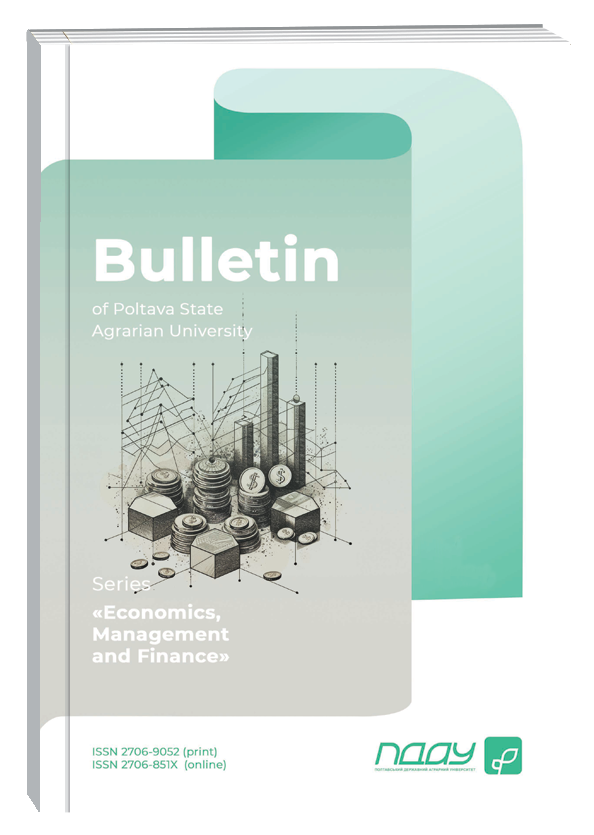IMPROVING CRISIS MANAGEMENT IN ENTERPRISES UNDER MARTIAL LAW CONDITIONS
DOI:
https://doi.org/10.32782/pdau.eco.2024.2.4Keywords:
crisis management, crisis, management levels, enterprise performance diagnostics, downsizing, outsourcing, regularization, benchmarking, modernization, diversification, mergers, reengineering, threats, developmentAbstract
The article examines the theoretical aspects of crisis management for enterprises under martial law conditions. It identifies the key differences between traditional crises and crisis situations that arise during armed conflict. Stages for developing a system of strategic guidelines for enterprises, tailored to the specific challenges of operating in the complex conditions of martial law, have been developed and proposed. During martial law, a significant portion of businesses reduce or cease operations, leading to a decline in GDP, reduced tax revenues, rising unemployment, and heightened social tension. The primary task for economic recovery in this period is to ensure the restoration and functioning of businesses in all possible forms. Each business entity must focus on maintaining uninterrupted operations and implementing effective crisis management strategies under martial law conditions. In this context, the study of theoretical and practical aspects of crisis management, as well as the improvement of management systems, including tools and methodologies for substantiating management decisions, becomes particularly important. The analysis of financial crises or the risk of bankruptcy involves a systematic approach aimed at forecasting crisis symptoms in enterprise operations and identifying their negative consequences. Such analysis emphasizes financial evaluation, which relies on a system of indicators. These indicators help reveal relationships between various aspects of enterprise operations and its financial condition. The main goal of diagnosing an enterprise during wartime is to assess its financial position and develop measures to quickly restore solvency and achieve a sufficient level of financial stability necessary to overcome the crisis. Diagnostics serve as a key component of crisis management for enterprises in wartime and should be carried out before the first signs of a crisis appear. This enables the enterprise to develop well-founded measures to prevent a financial crisis or mitigate its effects, assess the scale, scope, and depth of the crisis, analyze the enterprise’s capacity for maintaining stability, and forecast its future development.
References
Кодекс України з процедур банкрутства від 18 жовтня 2018 року. URL: https://zakon.rada.gov.ua/laws/show/2597-19 (дата звернення: 01.10.2024).
Ареф’єва О. В., Ковальчук А. М., Панчошна Т. М. Передумови формування стратегії антикризового управління на підприємствах транспортної галузі України. Ефективна економіка. 2022. № 12. URL: http://nbuv.gov.ua/UJRN/efek_2022_12_16 (дата звернення: 01.10.2024).
Болотнов Д. Г. Особливості антикризового управління вітчизняними підприємствами. Innovation and Sustainability. 2022. № 2. С. 171–176.
Коненко В. В. Цифровий інструментарій антикризового управління бізнесом в період воєнного стану. Ефективна економіка. 2023. № 1. URL: http://nbuv.gov.ua/UJRN/efek_2023_1_18 (дата звернення: 01.10.2024).
Левковець Н.П. Ефективність антикризового управління АТП в умовах відновлення країни. Фінансово-кредитне та обліково-аналітичне забезпечення післявоєнного відновлення економіки України: матеріали Міжнародної науково-практичної конференції, 5-6 жовтня 2023 р. Київ : НУБіП України, 2023. С. 461–463.
Плєшакова Н. А., Чухліб Г. В. Антикризове управління як протидія банкрутству: досвід українських підприємств мікрокредитування. Бізнес Інформ. 2023. № 6. С. 179–183.
Шуміло О. С., Савченко Н. О. Аналіз наукових підходів до визначення суті понять кризи та антикризового управління підприємством. Бізнес Інформ. 2021. № 4. С. 11–16.
Code of Ukraine on Bankruptcy Procedures of October 18 (2018). URL: https://zakon.rada.gov.ua/laws/show/2597-19 (accessed: 01.10.2024). [in Ukrainian]
Arefieva O. V., Kovalchuk A. M., Panchoshna T. M. (2022). Prerequisites for Forming a Crisis Management Strategy in Transport Industry Enterprises of Ukraine. Effective Economics, 12. URL: http://nbuv.gov.ua/UJRN/efek_2022_12_16 (accessed: 01.10.2024). [in Ukrainian]
Bolotnov D. H. (2022). Features of Crisis Management in Domestic Enterprises. Innovation and Sustainability, 2, 171–176. [in Ukrainian]
Konenko V. V. (2023). Digital Tools for Crisis Management of Business during Martial Law. Effective Economics, 1. URL: http://nbuv.gov.ua/UJRN/efek_2023_1_18 (accessed: 01.10.2024). [in Ukrainian]
Levkovets N.P. (2023). Effectiveness of Crisis Management in Transport Enterprises during the Country’s Recovery. Financial-Credit and Accounting-Analytical Support for Post-War Economic Recovery in Ukraine: Proceedings of the International Scientific-Practical Conference, October 5-6, 2023. Kyiv: National University of Life and Environmental Sciences of Ukraine, 461–463. [in Ukrainian]
Pleshakova N. A., Chukhlib H. V. (2023). Crisis Management as a Countermeasure to Bankruptcy: Experience of Ukrainian Microcredit Enterprises. Business Inform, 6, 179–183. [in Ukrainian]
Shumilo O. S., Savchenko N. O. (2021). Analysis of Scientific Approaches to Defining the Essence of Crisis and Crisis Management Concepts in Enterprises. Business Inform, 4, 11–16. [in Ukrainian]



